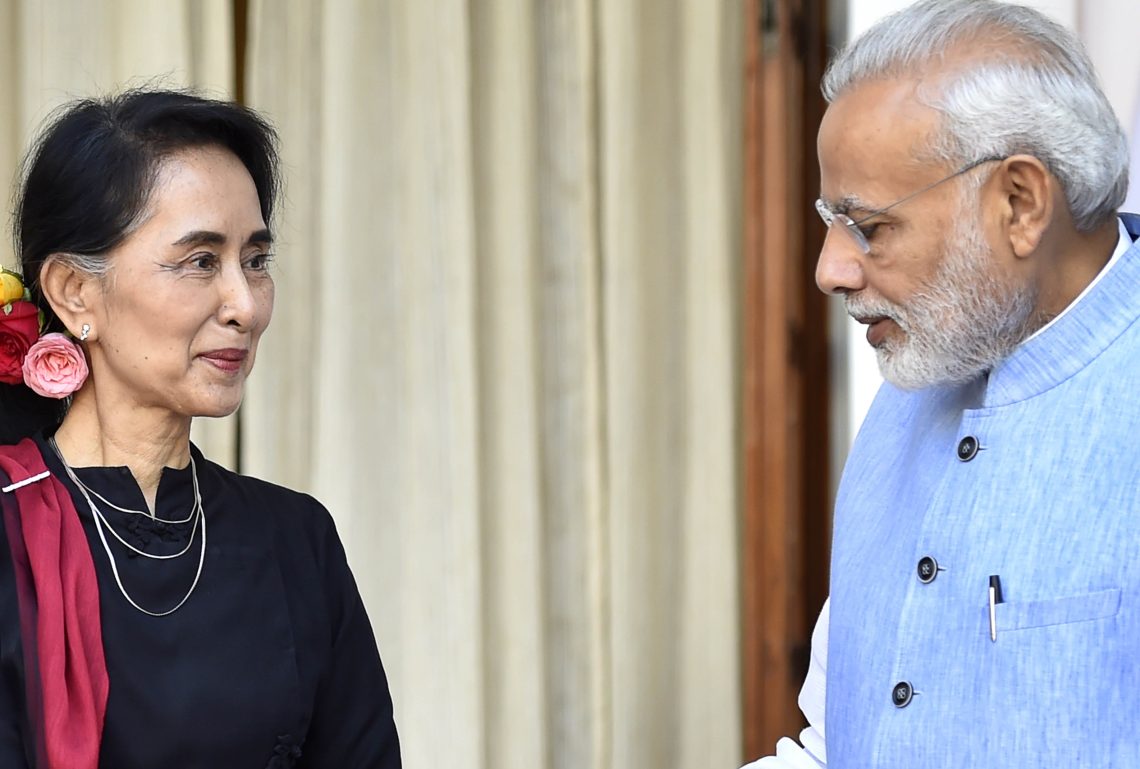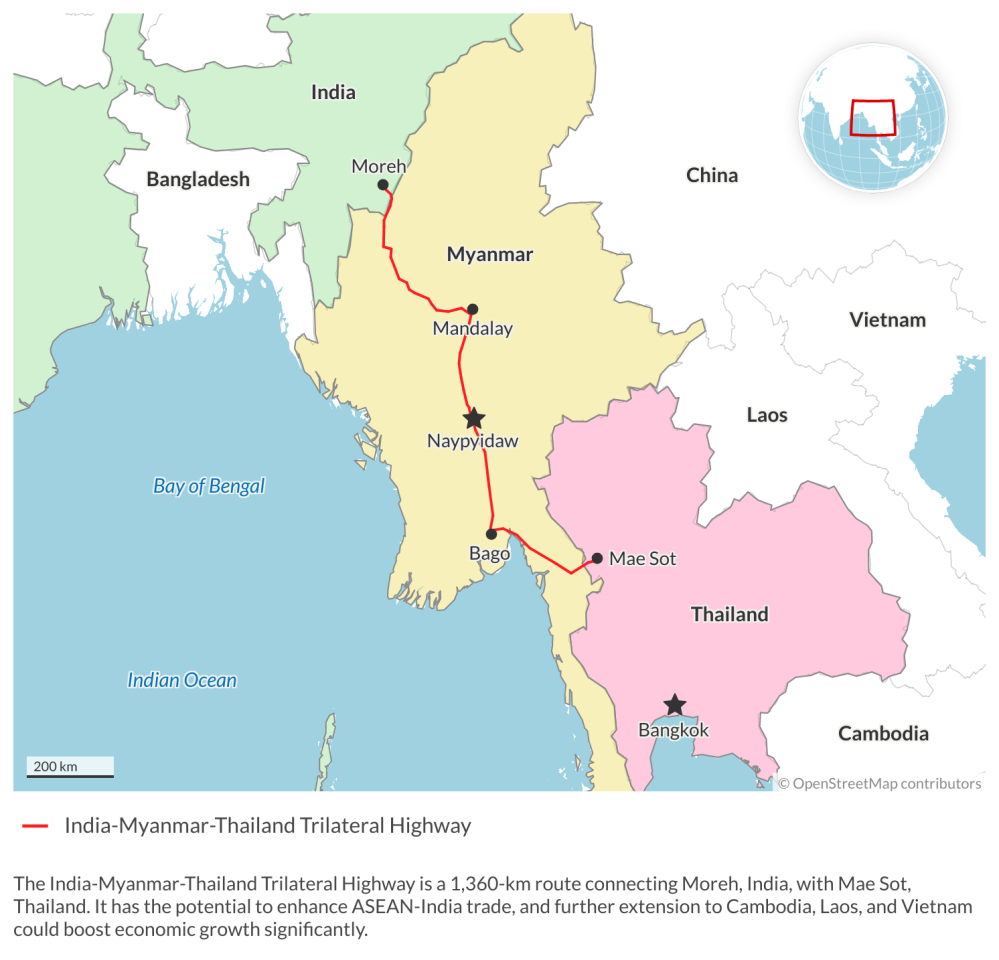India’s realpolitik Myanmar policy
While India needs to maintain good relations with Myanmar to achieve several strategic objectives, the ties between the two countries have been clouded by regional challenges.

In a nutshell
- India seeks closer ties and more connectivity with Southeast Asia
- New Delhi has maintained relations with Myanmar throughout turbulent times
- Chinese influence and insurgent groups at the border are posing a challenge
India’s diplomatic influence has grown significantly through 2023, attracting interest from countries worldwide looking to strengthen economic and strategic bonds with the South Asian nation. However, relations with its closest neighbors remain conflict-ridden and problematic. While its western neighbor Pakistan often captures international attention, its eastern neighbor, Myanmar (formerly Burma), is frequently overlooked.
India’s relations with Myanmar are multilayered: old historical ties, strong relations during the anti-colonial struggles of both nations against British rule, with many complications since the 1950s. In the 1990s, New Delhi launched its Look East policy (and later Act East), which emphasized regional connectivity, developmental aid and military support. In exchange, it sought support from Myanmar for security issues on Indian territory.
India’s foreign policy is a blend of idealistic principles and pragmatic considerations. While its leaders frequently emphasize moral and ideological values, realpolitik plays a significant role in shaping policy. This dynamic is made clear by interactions with Myanmar.
Political relations
India’s national struggle coincided with that of other colonial countries. India’s first prime minister and external affairs minister, Jawaharlal Nehru, built close relations with the founding elite of several countries in Asia and Africa. Burma was a part of the British Indian Empire until 1935. Nehru and Aung San, the founding father of modern Burma, knew each other well.
India’s relations with Burma were close during the first decade after each gained independence, and they signed a Treaty of Friendship in 1951 that declared “everlasting peace and unalterable friendship” between them. Both were also members of the Non-Aligned Movement.
Facts & figures
The 1962 military coup led by General U Ne Win that marked the end of constitutional democracy in the country also damaged ties with India. The inward orientation of the junta, repression of minorities and expulsion of foreigners – including ethnic Indians – created a rift between them.
However, after initially distancing itself, India maintained a middle ground in its policy, engaging in diplomatic relations with the regime while offering limited support to democratic forces.
India also supported Aung San’s family, especially his daughter, Aung San Suu Kyi, in their fight for democracy, and granted political asylum to former Prime Minister U Nu when he was exiled by the Ne Win regime.
At the same time, the countries maintained diplomatic relations. General Ne Win visited India in 1968, 1970 and 1980. Several successive Indian prime ministers visited Myanmar, more recently Manmohan Singh and Narendra Modi.
Aid and the China factor
From the 1950s onward, relations between China and Myanmar have been a concern for India. New Delhi has warily watched on as Beijing builds a network of friendly South and East Asian states relying on it for patronage – the so-called String of Pearls strategy, designed to encircle India.
Myanmar kept a neutral stance during the 1962 Sino-Indian war, which India interpreted as a pro-Chinese policy. In 1988, India publicly criticized the junta, sided with the pro-democracy uprising and offered sanctuary to Burmese dissidents. In retaliation, Myanmar began trading with China and purchasing Chinese weapons.
China and Myanmar share a 2,000 kilometer-long border, and China is Myanmar’s top trading partner and foreign investor. Beijing has frequently vetoed United Nations Security Council resolutions against the military junta and blocked the inclusion of Myanmar on the Security Council’s agenda.
Chinese investment in Myanmar currently stands at 26 percent of total Foreign Direct Investment and bilateral trade is $2 billion. In contrast, India’s bilateral trade with Myanmar was $1 billion in 2022.
Geopolitics in the 1990s necessitated that India build economic ties with countries in Southeast Asia to bolster investment and provide access to energy. New Delhi has long sought a stable Myanmar that keeps Indian interests in mind. Ideally, it would like to wean Myanmar from dependence on China.
The decade of semi-democratic rule in Myanmar from 2011 to 2021 provided India with a brief opportunity. There were several attacks on Chinese projects since Beijing was viewed as a strong supporter of the junta. Some projects were suspended, like the $3.6 billion Myitsone Dam in 2011, because of public concern over the dam’s social and environmental impact. With the return of the junta, some fear that its leader, Min Aung Hlaing, the army general who seized power in 2021, will revive the hydroelectric project to buttress ties with China.
China is Myanmar’s largest supplier of weapons and provides technical and other training to the Myanmar army. Since the 1990s, 60 percent of China’s arms exports have gone to three of India’s immediate neighbors: Pakistan, Myanmar and Bangladesh.
More by Aparna Pande
Pakistan’s economy shudders as army confronts its own mess
India basks in prominence on the global stage
India also has a long history of providing military aid to countries in its immediate neighborhood – Nepal, Bhutan, Sri Lanka or Myanmar. Since the 1950s, India has supplied weapons and ammunition to Myanmar, and this has continued irrespective of the government in power.
After the 2021 coup, according to a UN report from May 2023, Indian state-owned and private entities sold $51 million in arms and supplies to Myanmar’s military and defense companies, including radar technologies and remote-controlled air defense systems.
India’s northeast & Myanmar
There has always been an internal security dimension to India’s relations with Myanmar. Myanmar is key to India’s regional connectivity efforts – especially the Myanmar-Thailand-India trilateral highway and power grid linkages.
India’s northeast has long been home to insurgent groups, some demanding independence, others autonomy and still others tribal rights. From the 1950s onward, Pakistan and China provided varying degrees of support to these organizations. Camps and training facilities were set up in East Pakistan (later Bangladesh) and throughout Myanmar. As India’s relations with Bangladesh improved, Dhaka acted against these settlements and, in many cases, handed over the insurgents to India.
The rebel groups have ethnic links to populations inside Myanmar and have often used those ties to ensure their own safety. These groups have also used bribes to build a nexus in the lower rungs of Myanmar’s military.
India has often sought the support of the junta to act against these organizations. In 1967, India and Burma signed a border agreement for cooperation in counter-insurgency operations. In 2019, the armies of India and Myanmar worked on a joint operation against rebel groups based on both sides of their border. Such cooperation, however, has ebbed and flowed depending on how strong India’s ties are with the junta, which has at times ignored or even supported insurgent activities.
Burma’s civil war, which started during the 1960s and continues to this day, has also affected northeastern Indian states. Refugees, migrants and insurgents frequently cross the border into India to avoid repression inside Myanmar. Since the 2021 coup, over 50,000 civilians have fled. While India has allowed refugees into the country, it has refrained from publicly criticizing the junta.
Scenarios
The 2021 coup only reinforced India’s dilemma: how to reconcile the need for relations with a neighbor that is a continental gateway to Southeast Asia and critical to internal security concerns with support for the pro-democracy movement led by Aung San Suu Kyi.
Myanmar’s deepening economic turmoil – the economy has contracted by 12 percent since January 2021, according to the World Bank – will only exacerbate the civil war. Periodic bomb attacks on government compounds, like at the end of August 2023, the junta’s counterattacks and repression show no sign of abating.
More likely: continued engagement
The more likely scenario moving forward is that relations with Myanmar will remain the same. India will continue to engage the junta, maintain economic relations, offer military and developmental assistance and encourage regional connectivity – both by land and by bolstering electric grid connectivity. However, with a civil war on slow boil, the extent to which the Myanmar junta will listen to India’s concerns when it comes to security will be sporadic and limited.
India’s ability to balance relations with the junta and the pro-democracy movement will also be constrained. The regime is aware of the strategic competition between India and China and will seek to play one against the other to obtain benefits from both. India’s goal of regional connectivity with continental Southeast Asia through Myanmar will be hampered by the insecurity resulting from the civil war.
Less likely scenario: civil war spillover
The less likely scenario is that an exacerbation of the civil war inside Myanmar, not just between the junta and the pro-democracy activists but between the various ethnic groups inside the country, will lead to an escalation of violence. This, in turn, will cause refugees and insurgents to cross the border into India in large numbers. New Delhi’s response may vary but if this happens when elections are taking place, the state may opt to close the borders.
Such a move could strain India’s relations with pro-democracy activists. The junta might interpret it as support from New Delhi, though this would not be the government’s intention, while activists may urge India to accept more refugees.
India could face pressure from partners like the United States, Japan and European countries to take in more refugees. Even if India closes its borders, it would refrain from publicly endorsing the junta. Additionally, New Delhi would hope the junta addresses insurgent groups that pose a threat to India, although this may not be the junta’s top priority. In contrast, China might exploit the situation to endorse the junta’s policies, both privately and in international forums like the UN Security Council.
In an even less likely scenario, increased attacks by anti-junta groups could lead to a situation akin to civil war. This could result in a higher influx of refugees and insurgents into India. Indian insurgent groups might also use border regions to launch attacks within India while the junta’s control and interest in the territory diminish. In response, India would likely seal its borders, prevent refugee inflows and capture insurgents who enter. If the situation escalates, New Delhi may declare an emergency and deploy additional troops to restore calm.
For industry-specific scenarios and bespoke geopolitical intelligence, contact us and we will provide you with more information about our advisory services.










